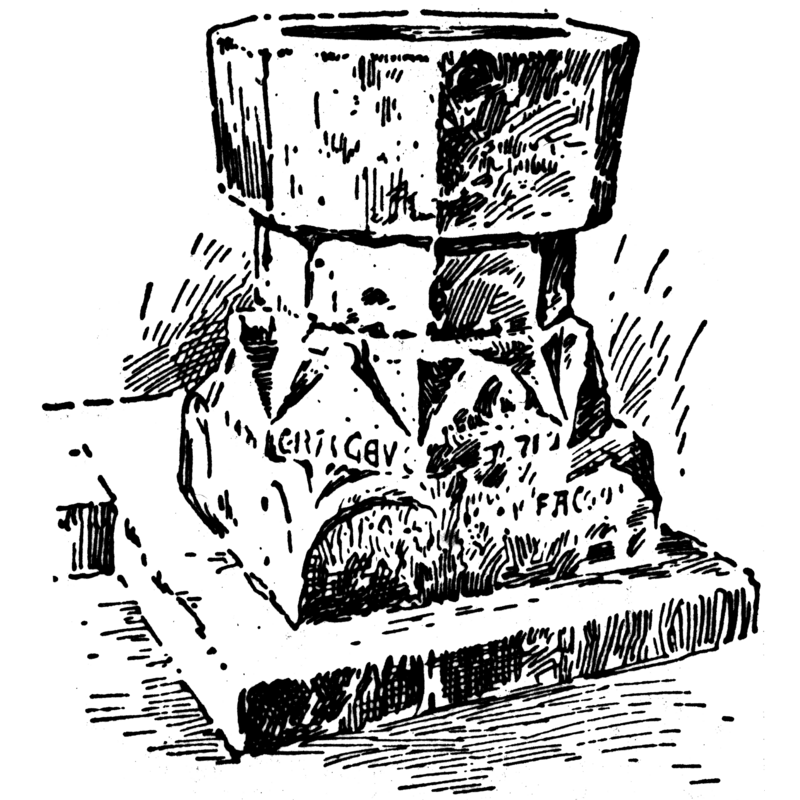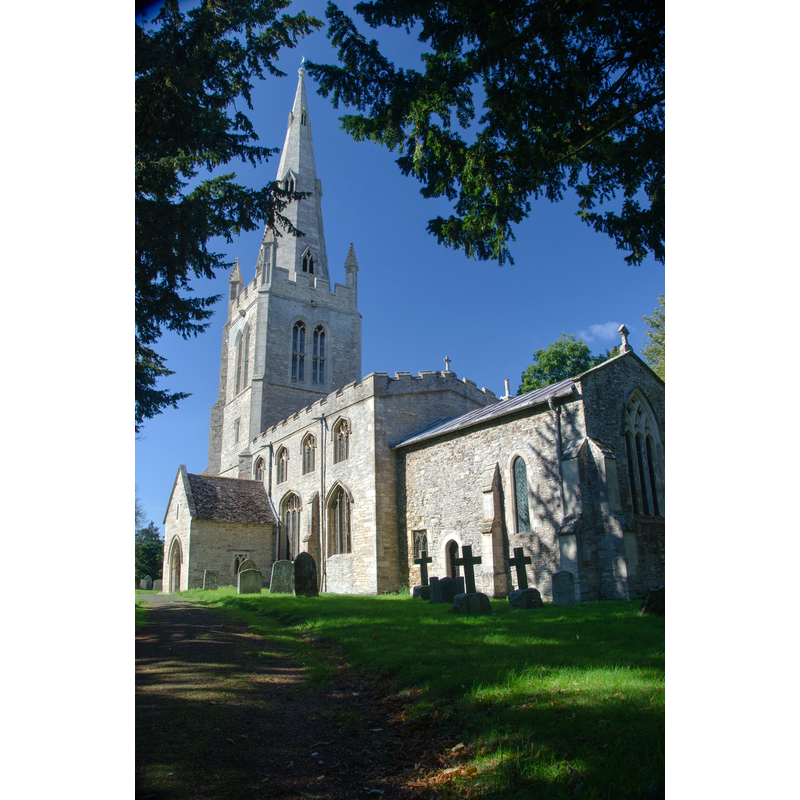Keysoe / Caisot / Caissot / Chaisot

Image copyright © Clip Art, et., 2015
No known copyright restriction / Fair Dealing
Results: 4 records
inscription
view of church exterior - southeast view
view of font
view of font
Copyright Statement: Image copyright © Clip Art, et., 2015
Image Source: digital image of a drawing in John H. Finley ed. Nelson's Perpetual Loose-Leaf Encyclopaedia (vol. 5) (New York, NY: Thomas Nelson and Sons, 1917), in ClipArt, etc. [http://etc.usf.edu/clipart/86900/86969/86969_baptismal-font-at-keysoe.htm] [accessed 14 September 2015]
Copyright Instructions: No known copyright restriction / Fair Dealing
INFORMATION
FontID: 01225KEY
Object Type: Baptismal Font1
Church/Chapel: Parish Church of St. Mary the Virgin
Church Patron Saints: St. Mary the Virgin
Church Location: Church Road, Keysoe, Bolnhurst, Bedford Borough MK44 2JP
Country Name: England
Location: Bedfordshire, East
Directions to Site: Located on the B660, 12-13 km N of Bedford, just N of Keysoe Row
Ecclesiastic Region: Diocese of St. Albans
Historical Region: Hundred of Leightonstone [in Domesday] -- formerly partly in Huntingdonshire
Font Location in Church: Inside the church, at the W end, N side (formerly in the S side)
Century and Period: 13th century, Early English
Font Notes:
Click to view
There are four entries for Keysoe [variant spelling] in the Domesday survey [http://opendomesday.org/place/TL0762/keysoe/] [accessed 14 September 2015], none of which mentions cleric or church in it. The Ecclesiologist includes notes from the 26th Meeting of the Cambridge Camden Society 1842, t. 1, no. 8), in which there is mention of a paper read by the Revd. W. Airy, "Vicar of Keysoe near Kimbolton" (p. 120, 124-125). The paper deals mostly with the inscription on the font in this church [cf. InscriptionArea] but there are a few additional comments worth noting here: "In the present instance, thanks to some barbarous churchwarden, the inscription is in tolerable preservation; for when I first came to this parish I found the Font wedged into the end of a narrow pew abutting upon one of the pillars; so that, being octagonal, five of its sides were effectually protected from injury, while a good coat of mortar and white-washings innumerable had almost done as much for the remaining ones. Fortunately, however, the mortar had given way on one side, and the lime-wash, though thick, still allowed the letters GRACE to be traced: so that having this indication that something yet remained behind, I at once removed the Font from its confined position, and by dint of scraping and scrubbing, at last laid bare the inscription on the eight sides. There was a little difficulty at first as to where the legend commenced, one line being headed by a cross, and another by a kind of colon, or three dots in a vertical position [...]", and, after giving his transcription of the inscription and a translation into modern French, the Vicar goes to suggest a Norman dating for the font. This is corrected by the editor of the paper, who adds: "The date of the Font is Early-English; so at least we conclude from the appearance of the moulding which runs round the top of the eight faces of the stone, and is carried over the edges of the pedimental buttresses which divide them." A medieval font here is described in Paley (1844): "Early English Font of rather massive character" with an inscription in Norman French; illustrated by Orlando Jewitt. In Batty (1848), who cites Paley. J. Carrick Moore, in a letter to 'Notes and Queries', Jan. 5, 1884, writes: "Your correspondent gives an inscription on a font at Keysoe, Bedfordshire, without explanation, perhaps because it may be deemed too easy. At first it seemed puzzling, but with a little pains I arrived at it. It reads thus: '+Cestui qui par d'ici passerai, pour Leal Newarel prie, que Dieu de sa grace vrai merci lui fasse. Amen.' Probably Leal Newarel was the donor of the font." Described in Romilly Allen (1888) as "an Early English font inscribed in Norman French". The octagonal basin and the upper part of the base stem, also octagonal, are plain, but the middle part of the base has a moulding which opens out to create angular roof-like sides; there is an inscription running on these latter sides and on the square volumen of the lower base below. The plinth is also square. Paley (ibid.) reports the font, which he dates to circa 1200, as having been half hidden by the pews of the west end, south side; "it was removed to the north side of the nave at the west end, and on being thoroughly freed from the white-wash and mortar, with which it was thickly covered, the inscription was discovered" (ibid.). Paley also identifies the material of "the bowl and plinth are of Barnack stone, the shaft of clunch" and reports a lining, no drain, and the remains of staples on the basin (ibid.). Lewis' Directory of 1848 notes: "a curious Roman font with a Norman-French inscription." Cox & Harvey (1907) described the inscription as "the only Norman-French font inscription-- 'Trestui ke par ici passerui / Pur le alme Warel prieu / Ke Deu par sa grace / Verrey merci li face. Am.' ('Pause, whoever passes by this spot, and pray for the soul of Warel, that God by His grace may grant him true mercy. Amen.')". In the Victoria County History (Bedford, vol. 3, 1912): "The church of Keysoe was given by Simon de Beauchamp to the priory of Chicksands in the reign of King John. [i.e., 1199-1216] [...] The plan of the nave and chancel is apparently that of a late 12th-century building, of which parts of the walls and the south doorways of nave and chancel remain. [...] The 14th-century font is octagonal on an octagonal base with gablets each side and is unusually interesting, having a long inscription on the base '+ Cestui ke par hici passerũt pur le alme Warel prieū ke Deu par sa grace verrey merci li face, Am.'" Pevsner (1968) writes: "Font. Of what date is that strange powerful base? It has thick, heavy spurs and eight gables with a ball finial. It has an inscription in French: Trestin qui par ici passerez / Pour l'ame de Wariel priez / Que Dieu par sa grace / Vraie merci li fasse. Amen" [a footnote in Paley adds: "Professor Bony suggests that Trestin = trestous, superlative of tour]. Can it be C13?."
COORDINATES
Church Latitude & Longitude Decimal: 52.25003, -0.428485
Church Latitude & Longitude DMS: 52° 15′ 0.11″ N, 0° 25′ 42.55″ W
UTM: 30U 675536 5791963
MEDIUM AND MEASUREMENTS
Material: stone, oolite (Barnack stone) for basin & plinth; base is clunch
Number of Pieces: three?
Font Shape: octagonal (mounted)
Basin Interior Shape: round
Basin Exterior Shape: octagonal
Drainage Notes: Paley reports a lining ca. 1844
Rim Thickness: 10.5 cm*
Diameter (inside rim): 54 cm*
Diameter (includes rim): 75 cm*
Basin Depth: 27.5 cm*
Basin Total Height: 32.5 cm*
Height of Base: 63.5 cm*
Font Height (less Plinth): 96 cm*
Notes on Measurements: * Paley (1844: unpaged)
INSCRIPTION
Inscription Language: Norman French
Inscription Notes: Modern French transl.: "Restez; qui par ici passerez / Pour l'âme de Warel priez: / Que Dieu par sa grace / vrai -or voir- merci lui fasse. Amen." -- English transl.: "All ye who pass by here, pray for the soul of Warel; whom may God by his grace grant true mercy. [Amen]" -- [cf. FontNotes]
Inscription Location: "upon the several faces of the pediment"
Inscription Text: Version 1): "+TRESTVI / KEPARHIC IPASSERVI PVRLEAL MEWAREL PRIEV / KE DEVPARSA GRACEVE RREYMERCILIFACE AM"
Version 2): "TRESTUI KE PAR HICI PASSERUI / PUR LE ALME WAREL PRIEU / KE DEU PAR SA GRACE / VERREY MERCI LI FACE. AM."
Version 3.): "+CESTUI QUI PAR D'ICI PASSERAI, POUR LEAL NEWAREL PRIE, QUE DIEU DE SA GRACE VRAI MERCI LUI FASSE. AMEN"
Inscription Source: Paley (1844: unpaged) for the original and the "modern" French translation [using probably the Ecclesiologist, vol. I, p. 124, as source] [Romilly Allen's and Paley's use of V vs. U varies slightly]. The English translation as given by Bond (1908 p. 113); a slightly different text in Cox & Harvey (1907: 182); version 3 a/p J. Carrick Moore -- cf. FontNotes]
LID INFORMATION
Notes: Paley reports "the remains of staples" on the basin top (Paley, 1844, unpaged)
REFERENCES
Victoria County History [online], University of London, 1993-. Accessed: 2011-04-01 00:00:00. URL: https://www.british-history.ac.uk.
Allen, J. Romilly, "On the Antiquity of Fonts in Great Britain", XLIV, Journal of the British Archaeological Association, 1888, pp. 164-173; p. 167-168
Batty, Robert Eaton, Some particulars connected with the history of baptismal fonts: being a paper read at the quarterly general meeting of the Architectural and Archaeological Society for the County of Buckingham, London: F. & J. Rivington, 1848
Betjeman, John, An American's Guide to English Parish Churches (including the Isle of Man), New York: McDowell, Obolensky, 1958
Bloxam, Matthew Holbeche, The Principles of Gothic ecclesiastical architecture, with an explanation of technical terms […], London: W. Kent, 1859
Bond, Francis, Fonts and Font Covers, London: Waterstone, 1985 c1908
Cox, John Charles, English Church Furniture, New York: E.P. Dutton & Co., 1907
Lewis, Samuel, A Topographical Dictionary of England, Comprising the Several Counties, Cities, Boroughs, Corporate and Market Towns, Parishes, Chapelries, and Townships, and the Islands of Guernsy, Jersey, and Man, with Historical and Statistical Descriptions [...], London: S. Lewis, 1831
Paley, Frederick Apthorp, Illustrations of Baptismal Fonts, London, UK: John van Voorst, 1844
Pevsner, Nikolaus, Bedfordshire and the County of Huntingdon and Peterborough, Harmondsworth: Penguin, 1968
[various correspondents], "Dates on fonts", 6th S: IX, Jan. 5, 1884, Notes and Queries, 1884, pp. 13-14; p. 13
![[cf. Inscription area and Font notes for details]](/static-50478a99ec6f36a15d6234548c59f63da52304e5/compressed/0011125064_compressed.png)
